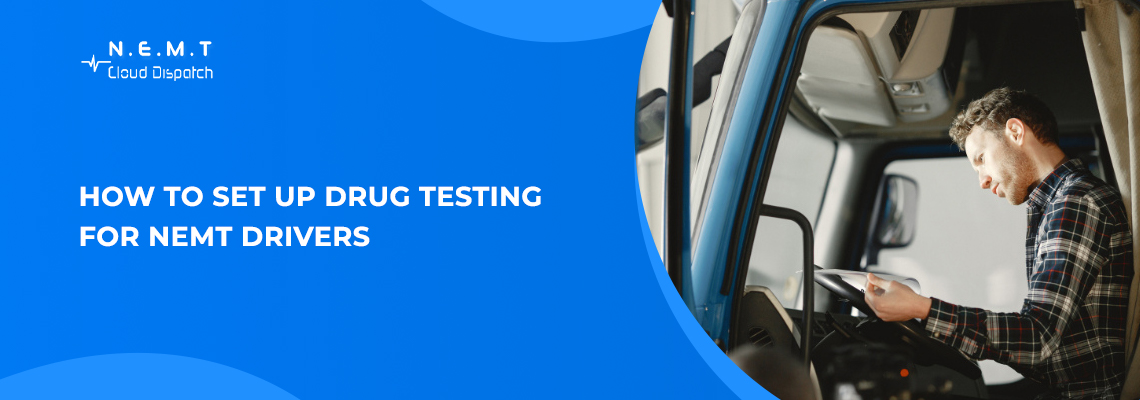Safety is not just a goal in the Non-Emergency Medical Transportation (NEMT) business; it’s a mission. NEMT drivers have implicit trust invested in them daily to take care of and move patients who are elderly, disabled, or have chronic illnesses.
For these types of patients, safety and reliability are not an option. One of the most important steps of having a safe and reliable operation is to have an entire, compliant, and fully operational drug testing program in place for your drivers. Drug Testing for NEMT Drivers is not compliance. It’s building confidence with your riders, their families, medical partners, and regulators.
Why Is Drug Testing for NEMT Drivers is important?
Once you’ve gotten clear on the legal model, the next thing is to craft a drug testing policy specific to your business. This policy in writing serves as the model for your compliance program. It should state who will be tested, what drugs will be tested for, when testing will take place, and how test results will be treated.
Define specifically which employees are subject to testing, usually all drivers operating in safety-sensitive positions, and identify each situation where testing is called for. Take the details here: How to Become a NEMT Driver
For instance, pre-employment testing has to be done prior to new drivers assuming any duty related to safety. Random NEMT driver drug testing has to be unforeseen and equally distributed all year round, with drivers chosen via a random system. In the case of an accident, post-accident testing has to be carried out in good time, typically within 32 hours after the accident has occurred.
NEMT compliance drug testing Methods: Pros and Cons
Method | DOT-Approved | Best For | Notes |
Urine | Routine testing | Long detection window but requires privacy | |
Saliva | On-site, fast testing | Easier to administer, detects recent use | |
Hair | Pre-employment | Long-term detection, not DOT-compliant | |
Blood | Post-accident | Accurate but invasive |
The NEMT compliance checklist is mentioned above. Recordkeeping is just as important as testing itself. All testing activities, including test dates, results, refusals, and actions taken as a follow-up, should be logged in detail. Such records should be stored safely and kept for the time legally mandated. Details are here for you: What type of insurance Does a NEMT Driver Need?
For instance, positive test results and documentation of subsequent actions must be retained for five years, but negative test results may be kept for a mere one year.
Requirements of Drug testing at federal level
The tests use specific thresholds for initial and confirmatory screenings. Here’s a quick breakdown of Drug Testing for NEMT Drivers:
- Marijuana
- Cocaine
- Codeine
- Hydrocodone
- Oxycodone
- Phencyclidine
- Amphetamine
Choosing the Right Testing Provider
Some may even assist in training your internal team, especially your Designated Employer Representative (DER), who is responsible for managing the program internally.
Using a Third-Party Administrator (TPA) can also be beneficial. TPAs can handle random test selection, maintain testing schedules, and ensure proper documentation, reducing your administrative burden.
Implementing the Testing Program
Having your policy and testing provider in hand, it’s time to roll out the program. Begin by testing all new hires prior to commencing work. Test randomly throughout the year without the benefit of patterns or predictability. Utilize a software solution or the system provided by your testing provider to randomly pull drivers and assign testing dates.
Click here to read the details:What Regulations and Training are Essential for NEMT Drivers?
In case an accident happens, have protocols set up to send the driver for post-accident testing right away. Reasonable suspicion tests involve supervisors being able to identify and document evidence of substance use. Ensure that your supervisors are equipped and comfortable with such a situation being handled sensitively yet firmly.
Positive Results and Refusals
As per the NEMT drug testing policy, if a driver is found positive or refuses to undergo a test, it’s important to act swiftly and go through the correct return-to-duty procedure. This includes taking the driver out of any safety-sensitive responsibilities and sending them to a Substance Abuse Professional (SAP). The SAP will evaluate the driver and suggest a treatment program, where needed. Only once the driver has attended the program and passed a return-to-duty test can they return to work.
Refusals need to be handled just as seriously as positive results. Whether you have a driver refuse to give you a sample, try to alter a specimen, or simply fail to appear at a scheduled test, you need to respond consistently under your policy.
Take insights here:Volunteer Driver Program: What You Need to Know
Keeping Your Program Up to Date
Non-emergency medical transportation drug testing and requirements keep changing. Saliva testing, for example, is a relatively new option for quicker and more convenient sample collection. Complacency is not an option. Stay up-to-date with DOT and FMCSA updates, regularly consult with your testing vendor, and check your policies annually for any updates.
Conclusion
At NEMT Cloud Dispatch, we assist NEMT providers not just with dispatch and scheduling but also compliance with critical compliance requirements such as drug and alcohol testing. If you’re searching for tools or partners to assist you in streamlining your compliance process, we’re here to assist you.
Make a program that doesn’t merely check regulatory boxes; make one that actually assists in a safer, more responsible workforce. That’s what professional, dependable NEMT service is all about.


